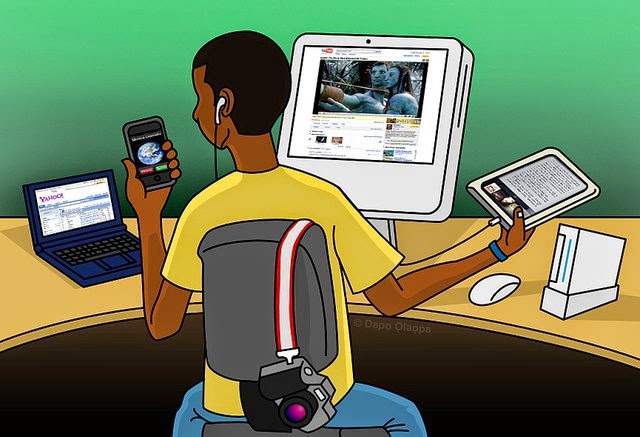IDEA-BASED ECOSYSTEMS
The primary reason people use social media is to showcase their own identities. It's essentially like a giant selfie. This is why a local cupcake shop will get more Facebook likes than a local construction company. It's a reflection of who we are. Any time you can tie your brand to the identity of the customer, you'll have a win on your hands.
THE AGE OF INFORMATION OVERLOAD
THE 4-SCREEN REVOLUTION
DECODING DIGITAL SIGNALS
Analytics are very significant to understand customers and change ways on how best to reach them. If 50 percent of your traffic is from mobile and your website isn't optimized for mobile phones, you're going to lose half of your traffic right there.
BUILD THAT SOCIAL LITERACY
All of your employees need to be social media savvy, not just the social media team. Each individual should be a creator, curator, and connector, and organizations should focus on agility, aggregation, and adaptability. Above all, people should be posting content that is relevant to the customer. You don't want to be like the person on Facebook who only shares updates about their dog.
THE POWER OF REVERSE-ENGINEERING
Companies should look beyond their own niches and industries when it comes to marketing ideas. Sometimes a company in an entirely different industry will have a great marketing tactic that none of your competitors have ever considered. So, watch out and think outside your comfort zone! Here's a good example!
The primary reason people use social media is to showcase their own identities. It's essentially like a giant selfie. This is why a local cupcake shop will get more Facebook likes than a local construction company. It's a reflection of who we are. Any time you can tie your brand to the identity of the customer, you'll have a win on your hands.
THE AGE OF INFORMATION OVERLOAD
In recent years, people have gone from information hunger to information overload. People would almost rather give out their social security number than their email addresses. But if you can become the go-to source for relevant information on a specific topic, customers will seek you out like they reach out to Upworthy and Pinterest.
SELL IT IN THE VIDEO
Internet users are more likely to finish a 30-minute video than they are an article. If you're not using online video, you're missing a big part of your audience. Plus, customers are increasingly making purchases directly through videos. A few examples: a new service called Insay and Target's "Falling for You" video campaign.
Consumers frequently use multiple devices at once--TV, mobile phone, laptop, and tablet. It wouldn't be pretty surprising if in 10 years, all that might be one device, but in the next two to five years, we actually expect an increase in the number of devices we are using at once. For companies, the challenge is to find ways to interact with users on multiple screens and to cope with ever-shrinking attention spans.
Analytics are very significant to understand customers and change ways on how best to reach them. If 50 percent of your traffic is from mobile and your website isn't optimized for mobile phones, you're going to lose half of your traffic right there.
All of your employees need to be social media savvy, not just the social media team. Each individual should be a creator, curator, and connector, and organizations should focus on agility, aggregation, and adaptability. Above all, people should be posting content that is relevant to the customer. You don't want to be like the person on Facebook who only shares updates about their dog.
THE POWER OF REVERSE-ENGINEERING
Companies should look beyond their own niches and industries when it comes to marketing ideas. Sometimes a company in an entirely different industry will have a great marketing tactic that none of your competitors have ever considered. So, watch out and think outside your comfort zone! Here's a good example!










